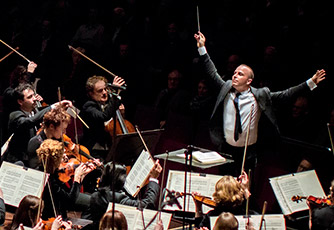
The first thing that I could say is “Wow.” I was so pleased with their playing that I did not want the concert to end. Each and every note was performed with so many different colors, with tones that we often cannot find in American-based orchestras. I was especially drawn by the extremely wide range of dynamics that the orchestra was able to produce, and the conductor Yannick Nézet-Séguin’s ability to convey all of his artistic visions with just his body language.
I was most inspired by their performance of Ravel’s Concerto for Piano in G Major (1931), with Hélène Grimaud on piano. Ms. Grimaud’s technique was beyond words — her fingers flew everywhere but knew exactly where to land, and produced the right kind of sounds for particular parts of the pieces. I absolutely love this concerto, and I was looking forward to hearing it live — soloist Hélène Grimaud and Rotterdam Philharmonic Orchestra with Maestro Yannick Nézet-Séguin all exceeded my expectations, and captured so many characters that this piece contains. They left me loving this concerto even more.
I also loved watching Maestro’s conducting style. A little bit of background story here: I am part of the conductor search for the orchestra I play in right now, and thus I’ve observed so many conductors in the past month. Through this search, I’ve realized that I really love it when conductors focus more on conveying the artistry rather than showing a steady tempo all the time. Mr. Nézet-Séguin’s conducting had just that — hand gestures that got the most out of the orchestra. How I wished he could conduct our ensemble! (Haha, right.) I had a lot to learn from the musicians in the orchestra as well, especially those in the woodwind section, who moved with the music to invite other players to play with them. It was beautifully done.
Rotterdam Philharmonic Orchestra was visiting Ann Arbor as a part of their U.S. tour, with the other stops at North Ridge, San Diego, Costa Mesa, Palm Desert, San Francisco, Chicago, and New York. They performed the same program — Ravel’s Ma Mere l’Oye and Piano Concerto in G Major as well as Tchaikovsky’s Symphony No. 5 — right before they left for the United States, in their hometown of Rotterdam, Netherlands. It is such an honor that an orchestra of this high caliber has visited Ann Arbor to share their art.




